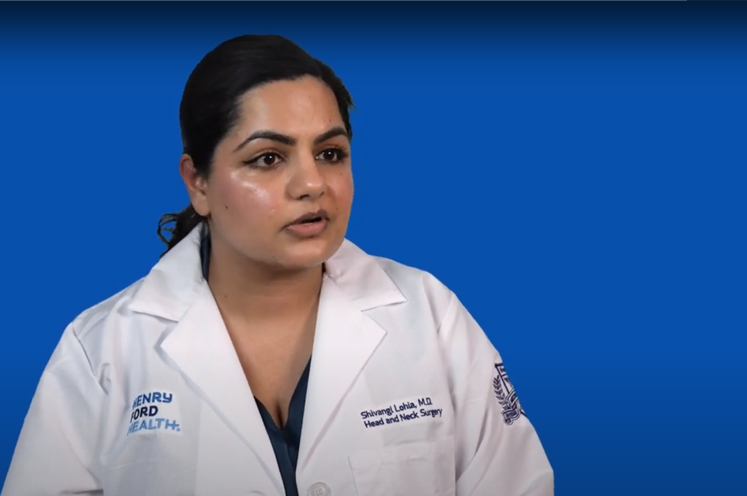Thyroid Radiofrequency Ablation (RFA)
The majority of thyroid nodules are benign and not life-threatening. However, even if not cancerous, they can still cause problems, including discomfort or pressure in the neck, difficulty swallowing or breathing and swelling or enlargement of the neck.
In the past, surgery was the only option to deal with this problem. While surgery is effective, it does leave a scar and it has risks. Henry Ford now offers RFA, which is non-surgical treatment appropriate for some patients.
What is thyroid radiofrequency ablation (RFA)?
Thyroid RFA is a minimally invasive medical procedure that treats thyroid nodules. Using ultrasound-guided imaging, the nodule is located, allowing the treatment to focus solely on the targeted nodular area. Using a radiofrequency generator, your doctor allows a carefully controlled amount of energy to flow through the electrode into the tissue to treat (ablate) the nodule. With the sustained RFA thermal heat, the nodule is broken down (degenerated) and gets smaller in size.
Every patient is different, some patients may be good candidates for RFA, but not all. Your doctor will discuss with you if your condition will be better treated with RFA or surgery.
Why choose thyroid RFA?
Thyroid RFA is a minimally invasive, non-surgical treatment for undesirable thyroid nodules. This procedure is a quick and safe option that enables patients to resume normal daily activity with minimal recovery periods.

Lisa's Story
Benefits of thyroid RFA
- Preserves your healthy thyroid tissue
- Allows your thyroid to function normally without the need for a lifetime of medication
- Minimally invasive procedure
- Decreases risk of permanent voice issues (hoarseness) that is associated with surgery
- Performed as an out-patient procedure, which means minimal downtime or hospitalization
- Shorter recovery times
- Limited scarring
- Low complication rate
- Improved quality of life
Risks of thyroid RFA
All treatments and procedures have risks and these will be discussed in detail with you by your doctor.
The RFA procedure and recovery
-
What happens during the procedure?
To begin the procedure, you will be asked to lie your head on a small cushion, with your neck extended. Two grounding pads will be placed on your thighs. Your doctor will clean and prepare the skin and then administer local anesthesia in the area surrounding your thyroid. You will be able to breathe, swallow and speak normally during the entire procedure.
A thin needle electrode will be inserted directly into the nodule and the doctor will allow a carefully controlled amount of energy to flow into the tissue to ablate (treat) the nodule. Ablative changes to the nodule caused by the treatment can be seen in real-time by the doctors performing the procedure. To ensure that you are handling the procedure well, your doctor may ask you how you are doing and whether or not you can feel any pain. They can easily make adjustments if you are uncomfortable at any time.
With the sustained RFA thermal heat, the affected nodule may be permanently destroyed. Your immune system will break down the affected tissue, shrink the nodule, and then let the affected tissue flow through the body naturally as waste.
When the procedure is complete, a small bandage will be placed on the treatment site, and ice packs may be used to cool your neck.
-
What to expect after your procedure
You will be monitored for a short period of time and then discharged. Please check with your physician before the procedure regarding driving as you may need someone to drive you to and from the procedure. You should be able to return to most of your day-to-day activities almost immediately.
-
What happens to the nodules after the procedure?
After the procedure, the cells of the treated thyroid nodule are removed by the body's immune system. Most patients notice a reduction in nodule size in just 2 to 3 weeks, with solid nodules taking longer than cystic nodules.
The amount of reduction depends on the original size and nature of the nodules. After three months, the average reduction rate is 40% to 60%, and about 60% to 90% reduction rate at the one-year mark. Years after the procedure, only the scar tissues will remain in the treated area. The nodule around the scar may still remain, but this area will be minimized after the procedure. The surrounding healthy thyroid gland will be preserved and will continue to produce thyroid hormone.
Symptoms like difficulty swallowing, pressure or tightness in the throat, or a bulky nodular appearance are typically eliminated or significantly reduced.
Locations for thyroid RFA
Two convenient locations are available for your thyroid RFA treatment, with an initial in person assessment at Henry Ford Medical Center - Templin and the actual procedure being performed at our Henry Ford Cancer Pavilion.
.svg?iar=0&hash=F6049510E33E4E6D8196C26CCC0A64A4)

/hfh-logo-main--white.svg?iar=0&hash=ED491CBFADFB7670FAE94559C98D7798)

